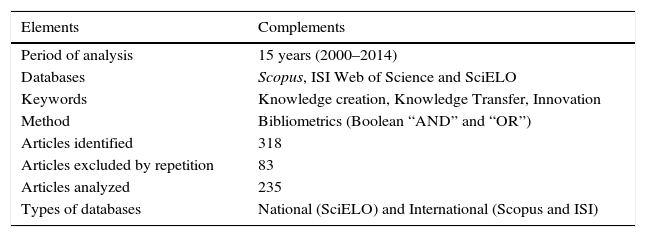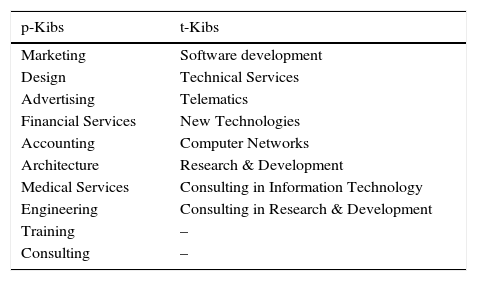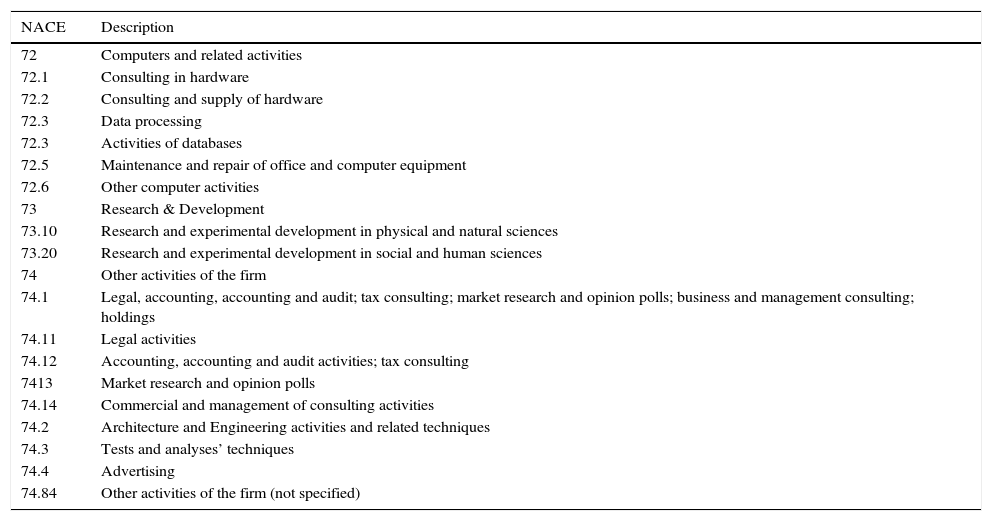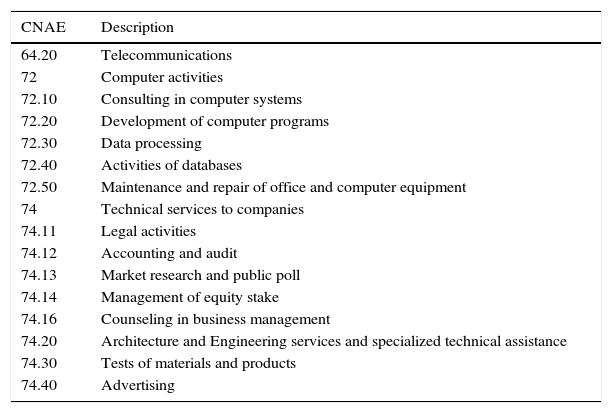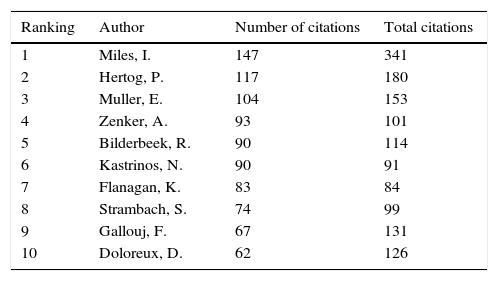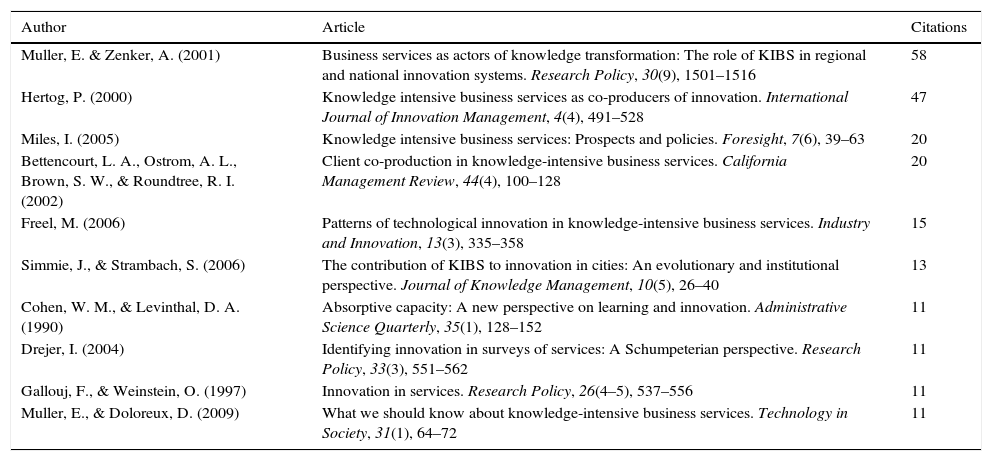This study analyzes scientific articles present in the databases Web of Science, Scopus and SciELO. Two hundred and thirty-five studies were examined, by using variations in bibliometrics. The main objective of this article is to analyze the set of studies that address the different behaviors Knowledge Intensive Business Services in the scientific literature. The results show a concentration of publications in the years 2005, 2010, 2012 and 2013, including the theme's interdisciplinary perspective. Most studies are quantitative and were published in the last five years. The first study was presented at an international conference in the year 2000. The most quoted authors were Hertog, Miles, and Muller. The set of publications examined presents two groups of behaviors: roles and attributes of Knowledge Intensive Business Services. This research aimed to analyze Knowledge Intensive Business Services over time and contribute to its expansion in Brazil.
Since the initial paper by Miles et al. (1995), literature has pointed to a new pattern of business innovation, due to the inability of traditional companies to make innovations by using the current management approach, defined as Knowledge Intensive Business Services – KIBS.
KIBS are recognized as essential constituents of innovation systems (Cooke & Leydesdorff, 2006) and are vectors of knowledge transmission (Hertog, 2000; Miles, 2008; Muller & Zenker, 2001), as activities of knowledge intensive services. KIBS emerged in the late 1980s and early 1990s, when researchers identified traits of some specific companies in the service sector (Bilderbeek, Hertog, Marklund, & Miles, 1998; Doloreux, Freel, & Shearmur, 2010; Miles et al., 1995; Miles, 2007).
The initial approach to KIBS began in the United States and in Europe (Hertog, 2000; Hauknes, 1998; Muller & Zenker, 2001; Strambach, 2001; Toivonen, 2004), mainly in Portugal, Spain, Sweden, Finland, Germany, and England - where the leading innovation center in the world is located at the University of Manchester. These studies addressed the role of KIBS as inducers of the innovation process in the new economy, including other sectors (Antonelli, 1998; Bilderbeek et al., 1998; Hertog, 2000; Kox, 2002; Nählinder, 2002).
In Brazil, especially in the last ten years, KIBS have been addressed by some researchers (Almeida, 2004; Freire, 2006, chap. 4; Jesus, 2005; Kubota, 2006), who observe that they are responsible for 39% of the revenues in the service sector, 27% of the salaries, 19% of the firms and 13% of the employed persons (Hoffman, 2009), and play a key role in the innovation process of knowledge-intensive businesses.
In this context, we note that KIBS have the potential to be deeply studied and discussed, regarding business competitiveness, in order to understand the differences in their behavior for the development of knowledge intensive services in Brazil.
The activities of knowledge intensive services refer to the production or integration of services in activities developed by companies and public agents, in manufacturing or services, in combination with outputs of manufactured goods or as autonomous services (OECD, 2004).
Based on this assumption, this article examines the academic research on management and presents a set of studies that address the different behaviors of KIBS in the national and international scientific literature.
The choice of databases for research was made according to the international relevance of the two main databases, ISI and Scopus, and of the national database, SciELO, in order to compare the number and quality of the publications for bibliometric analysis. Thus, it is possible to show the relevance of the study, if we consider the low production of articles on KIBS in Brazil, especially on bibliometrics.
To do this, we carried out a literature review on KIBS (Table 1) during fifteen years (2000–2014), through bibliometrics (Andrighi, Hoffmann, & Andrade, 2011), in the databases Scopus, ISI Web of Science and SciELO. By using the keywords (1) Knowledge Creation, (2) Knowledge Transfer and (3) Innovation we have identified 318 articles, based on the Boolean method “AND” and “OR”. After the exclusion of repeated articles, we reached the number of 235 studies that were analyzed.
Research synthesis.
| Elements | Complements |
|---|---|
| Period of analysis | 15 years (2000–2014) |
| Databases | Scopus, ISI Web of Science and SciELO |
| Keywords | Knowledge creation, Knowledge Transfer, Innovation |
| Method | Bibliometrics (Boolean “AND” and “OR”) |
| Articles identified | 318 |
| Articles excluded by repetition | 83 |
| Articles analyzed | 235 |
| Types of databases | National (SciELO) and International (Scopus and ISI) |
In general, the main results indicate a concentration of articles in the perspective of innovation roles, bridges and facilitators, regional and global features, protection of innovations through patents, technological contributions, ability for innovation management, transfer and diffusion of knowledge, considering the geographic, technological and network distances.
The studies focused on the interdisciplinary perspective, considering not only innovation, but also its relation with the areas of management and economics, developing approaches for the search of innovation, competitiveness and performance of organizations.
The aim of this article is to provide an overview of the main bibliographical references and interpretations on the behavior of KIBS, in studies that were carried out during fifteen years of scientific production, thus creating possibilities for future studies by other interested researchers.
This paper is organized in five parts, including this introduction. The theoretical framework presents a discussion about the literature, analyzing KIBS in a synthetic way. The third section presents the method used in the study. The fourth section presents the results of KIBS’ behaviors throughout the research. At the end, the fifth section presents the final considerations.
Theoretical frameworkResearchers and practitioners have recognized that far from being innovative latecomers or just intensive generators of technologies and novelties in manufacturing, services have become increasingly important activities for innovative companies (Howells, 2004; Tether & Metcalfe, 2004).
Having experienced a very fast growth since the 1970s, KIBS are increasingly recognized as essential constituents of innovation systems in services (Cooke & Leydesdorff, 2006) and are vectors of knowledge transmission (Hertog, 2000; Miles, 2008; Muller & Zenker, 2001), as they provide a platform for studying a set of integrated services for innovation, developing and co-producing knowledge together with their clients.
In more precise terms (Hertog, 2000), KIBS are defined as organizations or private companies that frequently use professional knowledge, whether related to a specific (technical) discipline or a (technical) domain, generating intermediary knowledge businesses (products or services).
They can be considered as a group of companies that find solutions for other companies, based on specific knowledge (Boden & Miles, 2000; Miles, 2005; Miles et al., 1995; Nählinder, 2002; Tether, 2004; Tomlinson, 2002).
They are primarily concerned with supplying knowledge intensive inputs to business processes and collaborative learning processes of other organizations, including private and public sector, in which KIBS provider and customer both learn to solve specific problems (Aslesen & Isaksen, 2007), as well as for client companies, which lead to the development of new knowledge resulting from cooperative learning (Hertog, 2000).
KIBS provide a platform to study a set of integrated services for innovation by developing knowledge together with their clients, in coproduction. They are referred to as facilitators, carriers or sources of innovation that result in knowledge creation, dissemination or accumulation (Hertog, 2000; Miles et al., 1995; Muller & Zenker, 2001; Wong & He, 2002).
They are considered agents of dissemination and transfer of knowledge and innovation to their clients, and cannot be dissociated from the environment – national and regional, economic and social, macro and micro (André, Feio, & Ferrão, 2002; Hertog & Bilderbeek, 1998; Hipp, 2000; Miles et al., 1995; Miles, 2007).
They are also classified and distinguished as two types: p-KIBS (professional services) and t-KIBS (technology-based use), as shown in Table 2 (Miles et al., 1995).
Types of KIBS.
| p-Kibs | t-Kibs |
|---|---|
| Marketing | Software development |
| Design | Technical Services |
| Advertising | Telematics |
| Financial Services | New Technologies |
| Accounting | Computer Networks |
| Architecture | Research & Development |
| Medical Services | Consulting in Information Technology |
| Engineering | Consulting in Research & Development |
| Training | – |
| Consulting | – |
For Nählinder (2002), there are several ways to classify KIBS, and for Wood (2002) there is no definition in the standard approach accepted for KIBS, but rather a consensus created by agencies and companies that belong to the service sector. In Europe it is known as NACE (Classification of Economic Activities in the European Union) and in Brazil as CNAE (National Classification of Economic Activities).
NACE identifies KIBS, at least in Europe, as a sector that comprises activities of information technology, research and development, among other businesses. Each category contains subcategories – such as computers and related activities, that are deployed into subcategories (hardware consulting, software, data processing, database activities, computers’ maintenance and repair), as shown in Table 3.
Classification of KIBS according to NACE Europe (sectors and subsectors).
| NACE | Description |
|---|---|
| 72 | Computers and related activities |
| 72.1 | Consulting in hardware |
| 72.2 | Consulting and supply of hardware |
| 72.3 | Data processing |
| 72.3 | Activities of databases |
| 72.5 | Maintenance and repair of office and computer equipment |
| 72.6 | Other computer activities |
| 73 | Research & Development |
| 73.10 | Research and experimental development in physical and natural sciences |
| 73.20 | Research and experimental development in social and human sciences |
| 74 | Other activities of the firm |
| 74.1 | Legal, accounting, accounting and audit; tax consulting; market research and opinion polls; business and management consulting; holdings |
| 74.11 | Legal activities |
| 74.12 | Accounting, accounting and audit activities; tax consulting |
| 7413 | Market research and opinion polls |
| 74.14 | Commercial and management of consulting activities |
| 74.2 | Architecture and Engineering activities and related techniques |
| 74.3 | Tests and analyses’ techniques |
| 74.4 | Advertising |
| 74.84 | Other activities of the firm (not specified) |
In Brazil the classification is made through the instrument of national standardization of the economic activities codes, and through the grouping criteria used by the various agencies that deal with Tax Administration.
It is a detailing of CNAE (National Classification of Economic Activities) applied to all economic agents engaged in the production of goods and services, and may include private or public companies, agricultural establishments, public and private organizations, non-profit institutions and autonomous agents (individuals).
At the Federal Revenue Office, CNAE is a code to be reported in the Registration Form of Legal Entities (FCPJ), which feeds the National Registry of Legal Entities (CNPJ).
Firms that operate in the following divisions of CNAE, and took part in the Annual Survey of Services (PAS), such as KIBS, can be seen in Table 4, as considered by Freire (2006, chap. 4).
Classification of KIBS according to CNAE Brazil (sectors and subsectors).
| CNAE | Description |
|---|---|
| 64.20 | Telecommunications |
| 72 | Computer activities |
| 72.10 | Consulting in computer systems |
| 72.20 | Development of computer programs |
| 72.30 | Data processing |
| 72.40 | Activities of databases |
| 72.50 | Maintenance and repair of office and computer equipment |
| 74 | Technical services to companies |
| 74.11 | Legal activities |
| 74.12 | Accounting and audit |
| 74.13 | Market research and public poll |
| 74.14 | Management of equity stake |
| 74.16 | Counseling in business management |
| 74.20 | Architecture and Engineering services and specialized technical assistance |
| 74.30 | Tests of materials and products |
| 74.40 | Advertising |
Based on the information provided about KIBS, no conclusion or consensus can be attained (Audretsch, 2012; Garcia-Quevedo, Mas-Verdu, & Montolio, 2013; Hertog, 2000); especially in Brazil, there is a lack on this topic to be explored by researchers.
MethodIn order to achieve the objective of this study, a bibliometric research (Garfield, 1979; O’Connor & Voos, 1981; Powell, Koput, & Smith-Doerr, 1996; Quinlan, Kane, & Trochim, 2008; Wasserman & Faust, 1994; White & Griffith, 1981; White & McCain, 1998) was carried out in articles dealing with the relationship between the main theme – Knowledge Intensive Business Services (KIBS) – and innovation.
We initially sought to analyze published works on the subject of the research – KIBS, using the keywords tree technique (Fig. 1), supported by the three laws and principles of bibliometrics – Bradford's Law, Lotka's Law and Zipf's Law, all described with their applications directed to the analysis of articles, words and authors most quoted in scientific papers (Farias Filho, 2009).
After the initial analysis, we present the structure of the keywords tree, used as a search engine, in order to find articles that would provide relevant information related to KIBS (Fig. 2).
After identifying the words and key terms – (1) Knowledge Creation, (2) Knowledge Transfer, (3) Innovation – we began the collection of indexed articles in the databases ISI Web of Science, Scopus and SciELO, using the Boolean method “AND” and “OR”. We found 318 articles related to the central topic of our research (KIBS), which was qualitative and exploratory.
Next, the articles pre-selected in the databases were exported and classified using the EndNote™ X7 resource (Farias Filho, 2009), and passed through a refinement process to identify duplication, after which 235 papers remained.
The documents were analyzed according to the concentration of articles per year (period of 15 years), lexical analysis, most cited articles, number of citations per author, number of publications per author and concentration of articles per year.
Bibliometric analysis of KIBSConcentration of articles per yearWe analyzed the distribution of the theme identified in the databases used in the study. We found increasing peaks of publications in the years 2005, 2008, 2012 and 2013 in all bases, with 2008 being the year with the highest incidence of publications in Scopus database. In 2009 there was a growth of publications in ISI database and a decrease in Scopus, which may be justified by an international conference on KIBS held that year. The first studies on KIBS were presented at conferences in the year 2000. The largest concentration of publications on KIBS occurred specifically between the years 2012 and 2013. Hence, we notice that the discussion of this topic is very recent and most papers were made in the last seven years, half of the time just for the beginning of publications. We also noted that this theme in SciELO database is very limited in terms of quantitative papers, thus increasing the relevance of Brazilian publications (Fig. 3).
Number of publications per authorThe largest number of publications is from authors D. Doloreux, R. Grandinetti, R. Shearmur and N. Toivonen, with twelve, six, six and six articles, respectively. All papers by R. Shearmur were done together with D. Doloreux, who in turn has a much larger network of co-authorship. The same applies to R. Grandinetti, who produced four of his articles with three other authors. We also observed other authors who are quite productive, but have always published individually, such as V. Baláž and S. Liu, with four articles each, and R. Huggins and M. Rodriguez, with three papers each (Fig. 4).
Number of citations per authorThe most quoted author in the studies, within the period of fifteen years, was I. Miles, totaling 147 of the 235 articles selected for analysis – 62.5%. The second most cited author in this set of papers was P. den Hertog with 117 articles – 50% of the articles selected for analysis. The third was E. Muller with 104 articles – 44% of the articles selected for analysis (Table 5). Each of them received more than 100 quotations of their papers. The relevance of these authors for the KIBS theme must be highlighted. Table 5 shows the number of citations and co-citations (total citations), which is strengthened in Fig. 5, in which we have analyzed the relationship between co-citation of the most relevant authors, with a significance factor above 0.5.
Authors’ ranking according to the number of citations.
| Ranking | Author | Number of citations | Total citations |
|---|---|---|---|
| 1 | Miles, I. | 147 | 341 |
| 2 | Hertog, P. | 117 | 180 |
| 3 | Muller, E. | 104 | 153 |
| 4 | Zenker, A. | 93 | 101 |
| 5 | Bilderbeek, R. | 90 | 114 |
| 6 | Kastrinos, N. | 90 | 91 |
| 7 | Flanagan, K. | 83 | 84 |
| 8 | Strambach, S. | 74 | 99 |
| 9 | Gallouj, F. | 67 | 131 |
| 10 | Doloreux, D. | 62 | 126 |
Fig. 5 helps to strengthen Table 5, showing the number of citations per author, considering the 365 articles analyzed through the use of the VantagePoint resource. The green and yellow circles indicate three different clusters that represent the concentration of the most mentioned authors in the study, in terms of citations, while the other colors represent different authors with their relevance to the theme and a smaller number of citations in relation to Miles, Hertog and Muller. It is noteworthy that most of those other authors refer to the three most cited in the analysis.
Most quoted articlesFrom this analysis we perceived that the three most quoted authors had their papers identified with at least 20 citations each. P. den Hertog, who independently published “Knowledge-Intensive Business Services as Co-Producers of Innovation” exceeded in 100% the number of quotations of I. Miles's “Knowledge Intensive Business Services: prospects and policies”. Similarly, E. Muller and A. Zenker, with their paper “Business services as actors of knowledge transformation: the role of KIBS in regional and national innovation systems”, overcame Miles's paper citations in 200% (Table 6).
Most quoted articles.
| Author | Article | Citations |
|---|---|---|
| Muller, E. & Zenker, A. (2001) | Business services as actors of knowledge transformation: The role of KIBS in regional and national innovation systems. Research Policy, 30(9), 1501–1516 | 58 |
| Hertog, P. (2000) | Knowledge intensive business services as co-producers of innovation. International Journal of Innovation Management, 4(4), 491–528 | 47 |
| Miles, I. (2005) | Knowledge intensive business services: Prospects and policies. Foresight, 7(6), 39–63 | 20 |
| Bettencourt, L. A., Ostrom, A. L., Brown, S. W., & Roundtree, R. I. (2002) | Client co-production in knowledge-intensive business services. California Management Review, 44(4), 100–128 | 20 |
| Freel, M. (2006) | Patterns of technological innovation in knowledge-intensive business services. Industry and Innovation, 13(3), 335–358 | 15 |
| Simmie, J., & Strambach, S. (2006) | The contribution of KIBS to innovation in cities: An evolutionary and institutional perspective. Journal of Knowledge Management, 10(5), 26–40 | 13 |
| Cohen, W. M., & Levinthal, D. A. (1990) | Absorptive capacity: A new perspective on learning and innovation. Administrative Science Quarterly, 35(1), 128–152 | 11 |
| Drejer, I. (2004) | Identifying innovation in surveys of services: A Schumpeterian perspective. Research Policy, 33(3), 551–562 | 11 |
| Gallouj, F., & Weinstein, O. (1997) | Innovation in services. Research Policy, 26(4–5), 537–556 | 11 |
| Muller, E., & Doloreux, D. (2009) | What we should know about knowledge-intensive business services. Technology in Society, 31(1), 64–72 | 11 |
The quantitative analysis (Fig. 6) was done by using the QSR Nvivo™ 10 software. Starting from non-structured data, we identified the most frequent words in the databases, through the analysis of the 235 articles’ abstracts, which characterizes a lexical analysis. The resulting “cloud of words” oriented our work in order to define the keywords that make up the abstract of our study, which are Innovation, Knowledge, Services and KIBS.
Results and discussionInitial contributionsThe scientific contribution on KIBS was built by several authors who have developed their research and publications, in some years more intensively than in others, as in the periods 2005–2008 and 2012–2013, with an initial concentration in 2005, due to studies published by Muller who, since 2009, has not kept the pace. Nevertheless, he is considered a most relevant author in the scientific research on KIBS.
In the first period, the authors focused on the attributes and roles of KIBS (Muller, Doloreux, Heraud, Jappe, & Zenker, 2008; Doloreux, Amara, & Landry, 2008; Ferreira & Quadros, 2006; Simmie & Strambach, 2006; Smedlund & Toivonen, 2007; Yam, Lo, Tang, & Lau, 2010), while others investigated the protection of innovations through patents and KIBS (Bader, 2008; Amara, Landry, & Traoré, 2008), and their technological contribution (Guimarães & Meirelles, 2014; Kubota, 2009).
In the second period, we noticed that publications are composed of studies carried out by authors such as Mukkala and Tohmo (2013) and Mas-Tur and Soriano (2013), who also investigate the characteristics of KIBS and start-up companies for improving their competitive capacity. Other studies address the variables, differences, and especially the ability for innovation management in KIBS (Asikainen, 2013; Hipp, Gallego, & Rubalcaba, 2013), as well as the transfer and diffusion of knowledge from geographic, technological and network distances (Segarra & Teruel, 2014; Najafi-Tavani, Giroud, & Andersson, 2013).
The continuity of Miles's research is quoted by other researchers such as Zenker, Bilderbeek and Kastrinos, but the current references continue to be Miles and Hertog, who address the importance of non-technological factors in innovation, such as new concepts of services, customer's interfaces and systems for service provision.
KIBS behaviorThere are several empirical articles of great value for the study, such as the one by Muller and Doloreux (2009), in which they present the attributes and role of KIBS in the innovation system, considering that: they depend heavily on professional knowledge; they are primary sources of information and knowledge; they use knowledge to provide intermediary services for the production processes of their clients; and they are especially important for business competitiveness.
Other authors base their study on the empirical analysis of Information Technology, exploring the lessons for modularity that can be drawn from the outsourcing of knowledge intensive services. Modularity is often presented as a design strategy that stimulates innovation (Miozzo & Grimshaw, 2005).
Others point out that in recent years an increased attention has been given to knowledge intensive services, which has emphasized the building of a general vision of the role and function of KIBS in innovation systems, as well as their activities of knowledge production, transformation and diffusion, especially in small and medium-sized companies (Muller & Zenker, 2001).
Amara et al. (2008) present their vision of KIBS in a study of the management of protection of knowledge-intensive innovations, from a multivariate model defined as multivariate probit (MVP), that considered many methods of intellectual property protection simultaneously. They concluded that patents, registration of project patterns, trademarks, secrecy and lead time are legal and informal methods of protection that are used together against rival companies.
Yam et al. (2010) analyzed sources of innovation, technological innovation capacity and performance in manufacturing industries of Hong Kong. They also explored the dual role of KIBS as sources of bridges and of innovation, concluding that the information available outside the company affect the capacity to innovate, while external expert organizations only affect resource allocation.
Bader (2008) analyzes in his study legal protection strategies in areas of emerging business, such as the service sector. He considers patents as a means of protecting innovations in services, in particular those that are knowledge-intensive. His contribution focuses on the opportunities and risks of intellectual property management.
Miles (2005) examined Knowledge-Intensive Business Services, considered by him as the fastest growing areas in the European economy, and increasingly important for the performance of sectors that are their clients.
Simmie and Strambach (2006) present a theoretical contribution for the understanding of the role of services in innovation in post-industrial societies. They argue that the role of KIBS in innovation can be understood in terms of evolutionary and institutional economics, where urban organizations are seen as dependent systems that need to operate in networks for the production and transfer of knowledge.
Smedlund and Toivonen (2007) introduced the concept of knowledge intensive services in the context of regional networks, and analyzed the roles of KIBS especially in the development of regional intellectual capital. They highlight that production networks should emphasize explicit knowledge while development networks should emphasize tacit knowledge. They also point out that innovation networks must emphasize human potential by providing the necessary information, so that they can function as sources of innovation and process facilitators.
Corrocher, Cusmano, and Morrison (2008) investigated the variety of patterns in different typologies of knowledge intensive services in the case of Lombardia, a developed manufacturing area in Italy, where industrial activities are undergoing a general change in content, incorporating superior knowledge. They have identified four KIBS’ profiles: interactive innovation mode, product innovation mode, conservative innovation mode and techno-organizational innovation mode.
Koch and Strotmann (2006) contribute with a multivariate empirical analysis of the determinants of performance after KIBS entry, presenting growth equations from functional links to knowledge providers, customers and cooperation partners, which impacted the performance of new KIBS.
Aslesen and Isaksen (2007) compare the relevance of two complementary approaches as analytical tools, regarding knowledge intensive services in innovation processes. The first approach focuses on the importance of business specialists’ knowledge in the innovation process, and the second concerns a broader set of sectors as potentially important providers of knowledge-intensive services. The analysis was made in two Norwegian sectors that use different kinds of knowledge – agriculture and the software industry.
Doloreux et al. (2008) conducted a large-scale survey with 1,124 KIBS companies in Quebec, Canada, in which they empirically explore the extent to which KIBS from different industries and regions differ in their characteristics and use of innovation practices. Results show that KIBS present different attributes and innovation behavior in all sectors.
Consoli and Elche-Hortelano (2010) critically address a conceptual flaw in the literature that portrays KIBS as a homogeneous group of activities, based on the analysis of official data on occupational information in the United States. Their conclusion is based on the existence of different routes to analyze the composition of industries and sectors, such as their outputs (products and innovations) or their inputs (labor, capital and materials).
Doloreux and Shearmur (2010) make a contribution to the relationship between space and innovation, and they argue that few papers take into consideration a broader structure within which companies operate. They believe that innovation varies both in the continuous space and in different territories. However, it is affected by the collection of information from companies.
Guimarães and Meirelles (2014) identified agglomerations of a specific type of KIBS, the Technological KIBS (T-Kibs), from the calculation of Location Quotients (LQ) of each district. By using software, they observed a high dispersion of LQ values, thus confirming the differences in activities in relation to the market and the production process.
ConclusionTo achieve the research objective – to present a set of studies that address different behaviors of KIBS in the scientific literature during the period 2000–2014 – we have observed a concentration of papers in two periods of time. Their approaches focused on analyzing roles, considered as KIBS mode of acting, either as facilitator, carrier or bridge to innovation, as well as their characteristics – regional, national and international, rural or urban, innovations’ protection through patents, and KIBS technological contributions, innovation management capacity, transfer and diffusion of knowledge (Cooke & Leydesdorff, 2006; Hertog, 2000; Miles, 2008; Muller & Zenker, 2001), considering the geographic, technological and network distances (Doloreux & Laperrière, 2013).
We also noticed that these relationships prevail in the areas of business, management and economics, developing approaches in search of innovation, competitiveness and performance of organizations.
Thereby, the research can be extended to examine KIBS’ contribution for the innovation of service companies, by creating correlations between their attributes and roles, so that the results may add to the improvement of service provision worldwide, and especially to the promotion of Brazil's economy and innovation.
Limitations of the studyThe study was limited to analyzing KIBS’ behavior in the period 2000–2014, considering fifteen years since the beginning of publications. In our analysis, we defined “behavior” as the ability to understand how the topic KIBS is addressed in the international and national literature. The result was established as a literature cut-off, through adaptations in bibliometrics for that period. We sought to analyze international and national publications in order to emphasize the relevance of the KIBS theme for Brazilian studies. Our paper does not intend to exhaust the theme. Therefore, some authors were not mentioned in the bibliometric analysis due to the employed variations, as, for example, the number of citations in relation to the others.
Conflicts of interestThe authors declare no conflict of interest regarding this publication.
Peer Review under the responsibility of Departamento de Administração, Faculdade de Economia, Administração e Contabilidade da Universidade de São Paulo – FEA/USP.










